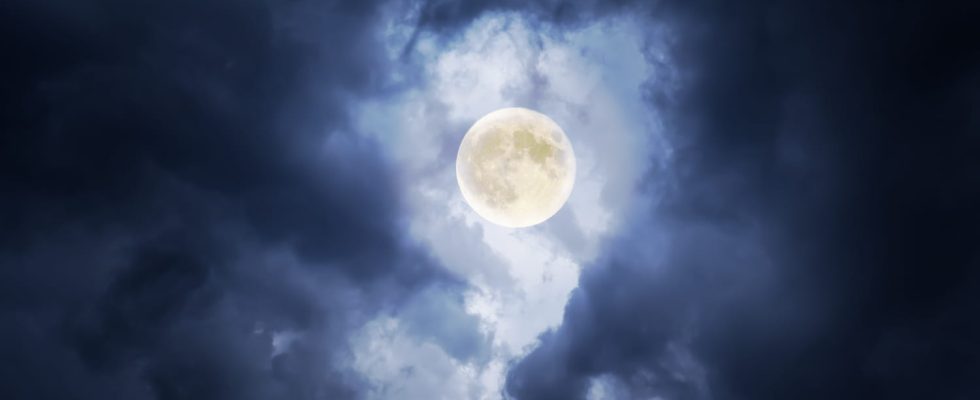SUPER MOON. This Thursday, August 31, 2023, skywatchers will be able to observe a super blue moon. What is the meaning of this designation? At what time and how to see it?
[Mis à jour le 28 août 2023 à 12h07] This Thursday, August 31 will be spectacular in the night sky with the announcement of a super moon which will be “the biggest and brightest full moon this year”, according to the specialized astronomy site Starwalk. “It will be 7.2% larger and 15.7% brighter than an average Full Moon”, at a distance of 357,344 km from Earth. Yes but why is this supermoon announced as a Blue Supermoon? It has nothing to do with its color. It is so called because it is the second full moon of a calendar month. A fact that only happens every two and a half years!
The use of the term “blue” would result from a blunder in an article in the American magazine of amateur astronomy Sky and Telescopein 1946. The article in question was titled Once in a Blue Moon and was written by journalist James Hugh Pruett who misinterpreted the Maine Farmers’ Almanac of 1937. And so that confusing phrase went around the world in no time… !
A blue moon is not a blue colored moon, but means that in the same month two full moons appear. Indeed, this year 2023, a first full moon appeared on August 1, and a second, the blue full moon, will appear this Thursday August 31. There is usually only one full moon in a month, the lunar cycle being 28 days. Exceptionally, the year 2023 has 13 moons instead of 12. As a general rule, only one Blue Moon is seen every 2.7 years. For astrologers, a blue moon signifies change or revolution.
The blue moon will be visible around the world at different times. “The moon is always full for everyone, but it moves. It takes 12 hours for it to move from one hemisphere to the other; that probably means it will rise early enough to have time to be full everywhere on the planet during the same day” had specified the president of the Corporation of astronomy of Val-Bélair, Jean David, to Radio Canada. Everywhere in the world it will be full at 01:35 GMT. In France, it will be exactly full from 3:37 am (Paris time) and visible all night from Thursday August 31 until dawn.
The full blue moon on August 31, 2023 will be observable from all parts of the globe, for all time zones. This means that it will necessarily be visible in the sky of France, provided that the sky is generally clear.
Every two to three years, the year includes 13 full moons instead of 12. The super blue moon is therefore associated with the number 13. Beliefs from the Middle Ages associate these years with 13 full moons with natural disasters, but gardeners evoke rather particularly rainy years not conducive to harvests.
In astronomy, this event is called “perigee-syzygia”, the name of Super Moon having nothing scientific, since it is an invention of the astrologer Richard Nolle in 1979. “A Super moon occurs when the full moon coincides with when the Moon comes closest to Earth in its elliptical orbit, a point called perigee,” explains the NASA website. By Super Moon, we therefore mean a celestial phenomenon that is due to two elements: the only satellite of planet Earth passes closest to us when it is a full moon evening. While waiting for the next photos, here are the most beautiful super moon pictures taken in France, the United States, China or even Russia:
The Super Moon is not really observable until after sunset. sun, with the naked eye, using binoculars or telescopes. In order to observe a Super Moon in optimal conditions, it is necessary to equip yourself with astronomical glasses or a telescope, far from atmospheric pollution, or go to one of the clubs of the French Association of Astronomy (AFA). See the map.
A Super Moon appears slightly brighter and larger than a Full Moon, simply because it appears at perigee, at its closest orbit point to Earth, less than 360,000 km away.
Due to the proximity of the full moon with our planet Earth, its effects have an even stronger impact on tides, mood and sleep. Indeed, as explained by a Swiss scientific study carried out in 2013 published in the journal Current Biology, “a lunar rhythm can modulate the structure of sleep in humans”. This means that the time to fall asleep is extended by 5 minutes, deep sleep reduced by 30% and sleep duration by 20 minutes. Consequently, the level of melatonin, a hormone secreted during our sleep, which has a role to play in mood, is lower, which can cause irritability or even depression.
| DATE | HOUR | DISTANCE FROM EARTH |
| Thursday August 31 | 3h35 | 357,344 km |
| Friday, September 29 | 11:57 | 361,552 km |
